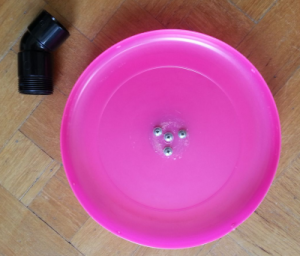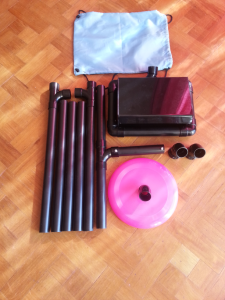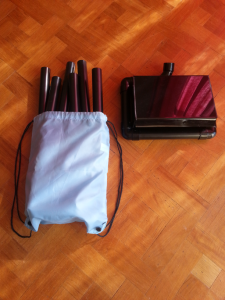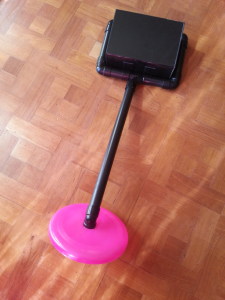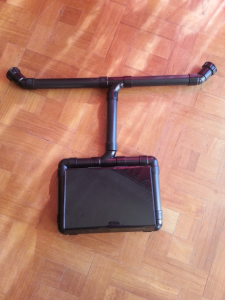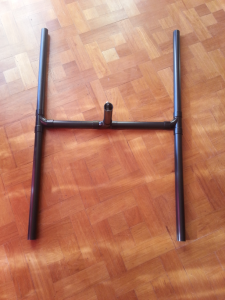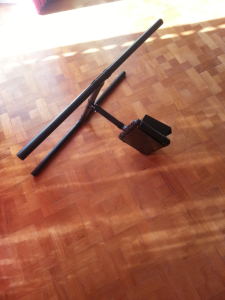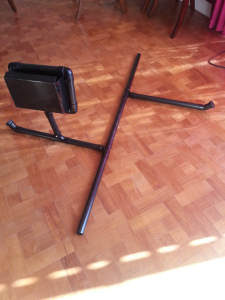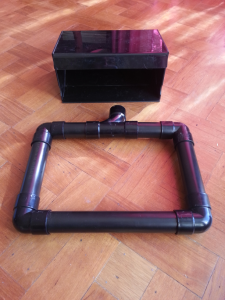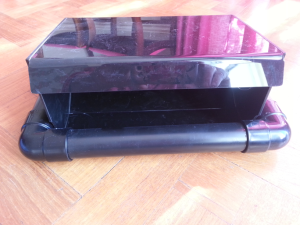Introduction
First off, you don’t have to build a set of pipes – the game will run perfectly well with just the tablet – the exception being that the tablet box we have designed lets you see what’s going on in bright sunlight and protects the tablet from mechanical harm and drizzle too. If you don’t want to build your own set, then we have organised for the people who make the boxes to supply a complete kit. It will cost in the region of £80, whereas you can make everything for around £30.
Anyway, building a set of equipment is fun so …
Let’s start
The general philosophy is to create using solvent weld plastic waste pipe. Where possible we weld the bits together, and where we can’t we use button clips to assist in a robust and childproof connection (picture from Magrenko). There are some photos how how the kit looks in its various guises below and there is a shopping list at the end of the page with everything that you need. Most of which you can get from your local DIY shop but I recommend Screwfix because you can place an order and then have it delivered. Velcro and Frisby you can get from eBay along with a gel case for your tablet. The boxes have been made specially by Striking Displays for Invisible buildings (they will supply the complete set of parts too) and the button clips come from Magrenko.
You will only need simple tools – a drill, saw and screwdriver plus some solvent weld cement. To get smooth ends when cutting pipe, I use a mitre saw in a guide such as this, but if you are careful a hacksaw will be fine – anything less than straight can alway be hidden in connector. An alternative is to use a plastic pipe cutter (about £15 from Screwfix).
You need a screwdriver to attach the Frisby to an end cap, and a drill to make holes for the button clips. The hole size is 12mm and it is best to make the hole with a connector and pipe in place and drill through them both. If you have access to a pillar drill, the task is simple. If you are using a hand drill, I recommend a special bit which will make a perfect hole (a normal bit will wobble and it may end up oval). I use an auger bit which drill slowly into the plastic and then cuts the hole. I put a block of wood inside where I am cutting as there is a tendency when the hole is drilled for the bit to go right through and start cutting the other side. Best to practise on a spare piece of pipe first.
Start by cutting all the pipe pieces to the correct size – try to be accurate but you have a little leeway when you push a pipe into a connector.
Two of the 500 mm pipes have nothing joined to them, and the other 2 have a T connector. Note that the Ts are not symmetrical – it makes no difference which way you attach them, but for neatness make sure that the two of them match. Note that the solvent weld cement is very quick acting so be sure to push the pipes right into the connector. Best strategy is to brush a layer of cement into the far part of the connector rather than on the pipe – if you do this, you will find that it oozes out. There are regulations for the sale of this cement – i.e. not for children, so you need to be aware of this.
You can now glue end caps to two 135 degree connectors and make up the cross piece consisting of a T and 3 bits of pipe. Note again that the T connector is non symmetrical – which is why the left and right bits are of different lengths.
The Frisbee is connected to an end cap (the actual cap). When we come to make up the metal detector we can screw the cap directly onto one of the end cap/135 degree connectors. In an ideal world, you could solvent weld to 2 bits together, but unfortunately, Frisbees tend to be made out of a different sort of plastic. So you can either screw in place with self-tapping flange screws (i.e. screws with a big head), or I guess you could sandwich the bits between 2 x 30mm washers and bolt together.
As with the Frisbee, the box plastic is non-weldable so we have devised a way to build the pipework around it so that it is held firmly in place. This is achieved with semi-circular holes in the front of the box and additional plastic pieces at the back. Note that once again, because the T connector is not symmetrical, the pipes joining it are not equal. Study the photograph carefully before glueing. We suggest that you make the front and back bits first – the front 90 degree bends will grip the outside of the box, thus at the sides, the pipes make good handles whilst using the equipment.
and finally in more detail where we put the clips
All the bits needed into drawstring gym bag that can be carried by a child, and yet still can emerge into different machines for the five games. Here’s how that looks. There is:
- a box into which the tablet is placed. The box is surrounded by a set of pipes which we will detail in a bit, and to which other bits can be added.
- below the box on the right you can see two 135 ends (135 degree bends with end caps).
- and below this the metal detector base (yes, it is a frisby).
- to the left is the T piece (3 pipes arranged at a T).
- and to the left of this are two connector arms ( 2 pipes with T connectors at one end)
- and 2 plain arms (just pipes)
We will now run through how the pipes look in each of the five games. In order these are for the metal detector, squirrel sorter, geophys, mole digger. We use the same configuration for diggory drop as in the squirrel sorter – the logic behind this is as there is quite a bit of running needed – keep the equipment light.
Here is the metal detector layout. We have the base screwed to a 135 degree bend. We will show more of the constructional details later. Here we are more interested in how the bits are assembled for game play.
Below we have the T piece which is uses in all games except metal detection. Here the T is simply attached to the box, with 135 ends on the other arms. We use this in Squirrel Sort and Diggory Drop.
We now see the geophys set up (Geophys was the inspiration for using pipes in the first place, as this is exactly how some geophys equipment looks and before black was the new white (see here). Here we attach 4 arms (first the 2 connector arms and then the plain ones) to the T piece which is still connected to the box.
Finally we see how to set up the Mole digger. Again the T piece is connected to the box. On one end we have a 45 end. The other has one connector arm, with the other connector arm below. Plus one plain arm above and the second to the side with a 135 end. This arrangement makes it easy for the person looking at the tablet to go round in circles. The other parts can be held onto by team members keeping it all steady.
Parts List

